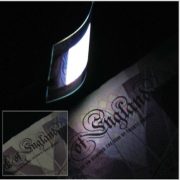Seoul National University’s Research Team Lead by Professor Changhee Lee Succeed in Developing High Output QLED Emitting True Ultraviolet Light
South Korean research team lead by Professor Changhee Lee in Seoul University succeeded in making first quantum dots that emit ultraviolet light and used them to produce a flexible, light-emitting diode.
UV light is usually produced by mercury lamps or LEDs made from inorganic materials such as gallium nitride (GaN). However, mercury lamps tend to emit a wide range of visible wavelengths as well as UV, and high-performance gallium nitride LEDs are expensive to make. According to Professor Lee, quantum dots are an attractive alternative which can be made using potentially less expensive solution-based processes.
Quantum dots, made out of a semiconductor material, emits different wavelengths depending on the size and shapes. The smaller the crystal, the shorter the wavelength of the light it emits. The Professor Lee’s team is the first in succeeding in making quantum dots that emit wavelengths shorter than about 400 nm, the high end of the UV spectrum.
In order to produce UV nanocrystals, the team had to figure out how to make quantum dots with light-emitting cores smaller than 3 nm in diameter. To make these, the team utilized cadmium zinc sulfide, which emits high-frequency light, zinc sulfide shell. The quantum dots produced through this method emit true UV radiation at about 377 nm. Professor Lee explained that they “can go to much shorter wavelengths than people generally expected from quantum dots”.
The research group then made a flexible LED with the quantum dots, using a design for a high-efficiency device they developed in 2012. Professor Lee’s team showed that the UV LED could illuminate an anticounterfeiting mark in a bill of paper currency. Franky So, a materials scientist at the University of Florida, says making a device out of the quantum dots that shines brightly enough to reveal the currency mark is a remarkable accomplishment. If their lifetimes can be improved, these potentially low-cost UV LEDs could find uses in counterfeit currency detection, water sterilization, and industrial applications.
The research team headed by Professor Lee includes Seoul National University, Professor Seonghoon Lee and Professor Koonheon Char, and Dong-a University’s Professor Jeonghun Kwak. The research was published in Nano Letters (Nano Lett. 2015, DOI: 10.1021/acs.nanolett.5b00392), a monthly peer-reviewed scientific journal, and reported on Chemistry & Engineering (27 May), published by the American Chemical Society.


